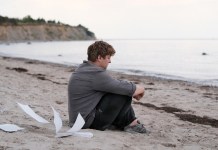The school year is half over and Anna (Ella Hunt) can’t wait to escape to Australia, even if it means missing the Christmas show in order to work off her ticket at the local bowling alley. After all, she’ll be sharing the graveyard shift with John (Malcolm Cumming), her best friend and secret admire, who has Christmas spirit to share. As the show gets underway back at school, and singer Lisa (Marli Sui) takes to the stage, her boyfriend Chris (Christopher Leveaux) is across town at a local soup kitchen filming with class activist Steph (Sarah Swire) when violence breaks out in the queue. Little Haven’s resident Santa is sick, you see, and it’s contagious.
Since their introduction in 1932’s White Zombie the walking dead have proliferated, the subgenre since reaching pandemic proportions with a staggering fifty-five installments released in 2014 alone. Zombies have spread from America, where they evolved under the late George A. Romero, to just about every corner of the world, infecting New Zealand in Peter Jackson’s Braindead, Cuba in Alejandro Brugués’ Juan of the Dead and South Korea in Yeon Sang-ho’s Train to Busan. In England Danny Boyle brought the horror home with 28 Days Later, but what has been missing until now is a Scottish perspective on the epidemic — Wales having featured as the unlikely setting for the last act of World War Z.
The sight of Jackie Bird reporting on the end of the world isn’t the only novel aspect of John McPhail’s Anna and the Apocalypse, for not content with being a simple rom-zom-com in the vein of Shaun of the Dead, arguably its closest cousin, the film is also a coming-of-age story, a Christmas film, and, as if that wasn’t already enough to set it apart from the horde, a musical. Think Once More With Feeling, Joss Whedon’s musical episode of Buffy the Vampire Slayer, and you’ll get a sense of what the film is going for — catchy songs and a kick-ass heroine, with traces of the same adolescent allegory that made the show’s earlier seasons so special. This is really the first zombie outbreak of the millennial era, where the only clear distinction between the living and the dead is an active Twitter account.
One of the first things you notice watching Anna and the Apocalypse is the frequent use of the word zombie — still something of a rarity in the subgenre. It helps to make the premise that much more relatable, if still far from realistic, as for once the characters recognise what is happening and accept the apocalypse for what it is. Not only does this keep things moving but it also allows talk to turn to more important matters, such as which undead celebrities the survivors would shag, marry or kill. At first the anarchy is exciting, leading evacuees to post evac selfies and others to pursue vigilante fantasies, but before long the teens are as bored of the chaos as they were of the order that preceded it. Screenwriters Alan McDonald and Ryan McHenry, who originally explored the idea in a YouTube short before sadly passing away in 2015, have crafted characters that are well observed and relationships that are keenly felt.
If there is a weak link it is perhaps the performances, the eminently likable cast sometimes struggling to navigate the frequent and often frantic shifts in tone, though it must be said that they do manage to hit the vast majority of their comedic and emotional queues without issue. (The older cast members fare better, with Paul Kaye having a field day with his homicidal headmaster and Mark Benton really making you feel for Anna’s father.) For a custom cult classic such as this, however, a few awkward pauses or ropy deliveries are to be expected, celebrated even, and seem inconsequential in the face of all that has been achieved, from the spectacular production values to the showstopping musical numbers. Anna and the Apocalypse is a festival (and festive) delight. It’s pure dead brilliant.






